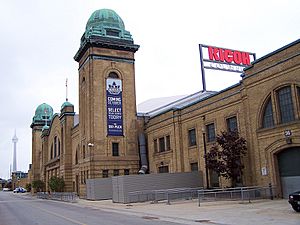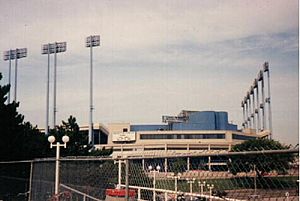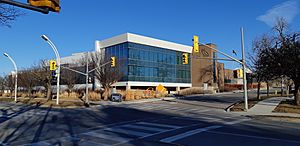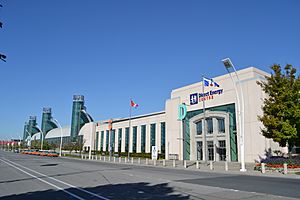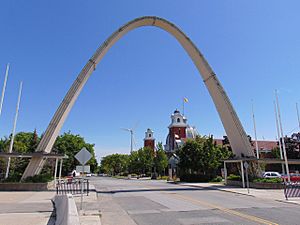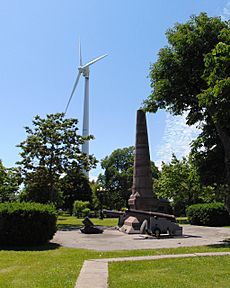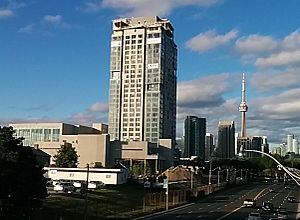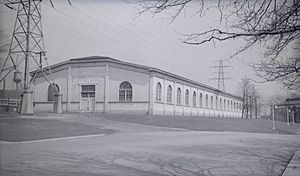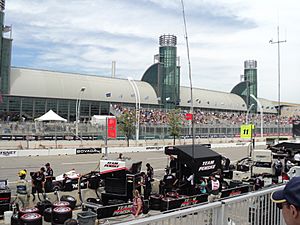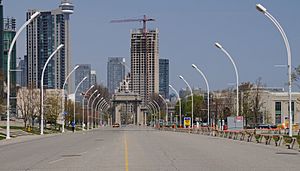Exhibition Place facts for kids
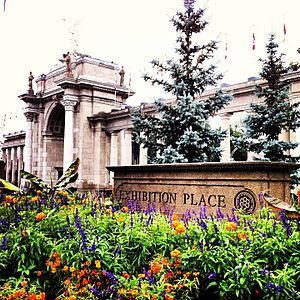
Exhibition Place is a big area in Toronto, Ontario, Canada. It's right by the Lake Ontario shoreline, just west of downtown. This huge space is owned by the public and has many different uses. It covers about 197 acres (80 hectares). You'll find exhibit halls, places for trade shows, banquet rooms, theatres, music venues, monuments, parks, and sports fields here. Many of these spots are also important historic sites for the city, province, and country. People use the buildings all year for shows, events, and sports.
Every year from mid-August until Labour Day, the Canadian National Exhibition (CNE) takes over the grounds. This is where Exhibition Place gets its name! During the CNE, the area grows to 260 acres (1.05 square kilometers), including nearby parks and parking lots. The CNE uses the buildings for displays about farming, food, arts, crafts, and different businesses. For fun, the CNE has a midway with rides and games, music concerts at the Bandshell, special shows at the Coliseum, and the Canadian International Air Show. The CNE is one of the biggest and most popular fairs in North America. It's a really important part of Toronto's culture.
The buildings at Exhibition Place are very old, some from the 1700s, and some are quite new. Five buildings (the Fire Hall/Police Station, Government Building, Horticulture Building, Music Building, and Press Building) were named a National Historic Site of Canada in 1988. This means they are very important to Canada's history. The land was first used for military purposes, but over time, it became a place for exhibitions. One military building still stands today.
Contents
Exploring Exhibition Place
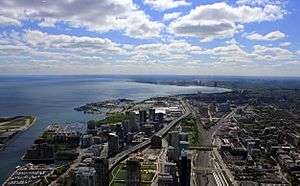
Exhibition Place is a long, rectangular area along the north shore of Lake Ontario, west of downtown Toronto. The land is mostly flat and gently slopes towards the lake. It used to be a forest, but it was cleared for military use a long time ago. Some parts of the land were filled in during the early 1900s. Today, much of the area is paved, but there's still a nice park in the western part. A large paved area in the middle is used for parking and for the fun rides of the Canadian National Exhibition (CNE). The site has many historic buildings, open spaces, and monuments.
The main entrance to Exhibition Place on the east side is called the Princes' Gates. These grand gates are named after Edward, Prince of Wales, and his brother, Prince George, who visited in 1927. The roads inside Exhibition Place are mostly named after Canadian provinces and territories. The main east-west street is Princes' Boulevard. Some of these roads are used for the yearly Honda Indy Toronto car race. South of Exhibition Place is Ontario Place, a theme park built in 1971 on land created in Lake Ontario.
Exhibition Place has a long history of sports. It started with a horse racing track and a grandstand. This grandstand later became a place for music concerts and games for major league baseball and football teams. The newest sports building is BMO Field, which is a stadium just for soccer. There's also the Coliseum, which is home to professional ice hockey. Exhibition Place was also used for many sports events during the 2015 Pan American Games.
The City of Toronto government manages Exhibition Place through a special board. In 2014, the site had 133 full-time workers, and up to 700 during big events. It brought in $11 million for Toronto each year and welcomed 5.3 million visitors. The grounds cover about 192 acres (78 hectares).
A Look Back: History of the Grounds
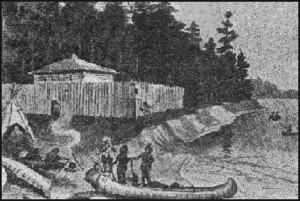
A small fort called Fort Rouillé was built by French fur traders in 1750–1751. It was a trading post on the land where Exhibition Place is now. This area was important for Native Americans who used it as a portage route (a place to carry canoes between waterways). The French wanted to trade with them before they reached British trading posts to the south. The French soldiers burned the fort in 1759 when other French forts on Lake Ontario were captured by the British.
When the town of York (which later became Toronto) was started in the 1790s, the land east and west of the military fort (later Fort York) was kept for military use. This included all of today's Exhibition Place. Later, the British military decided to build a new fort, New Fort York (later called Stanley Barracks), west of the old one. To pay for this, they sold the eastern half of the military land. In 1840–1841, they built six stone buildings and several smaller ones. The fort had a wooden fence around it, but strong defenses were never built. The fort was given to the Canadian military in 1870 and was named Stanley Barracks in 1893.

The Provincial Agricultural Association started the Provincial Agricultural Fair of Canada West in 1846. This fair was held every year in different places. For the 1858 fair in Toronto, a permanent "Palace of Industry" was built. It looked like London's Crystal Palace and was located at King and Shaw Streets. This site hosted four more fairs until the 1870s. Then, the City of Toronto decided the fair needed a bigger space. In April 1878, the City leased a part of the military land from the Government of Canada. The Palace of Industry was moved to this new site, near where the Horticulture Building is today, and it was rebuilt and made bigger.
The 1878 Provincial Agricultural Fair was held on these new grounds. When Ottawa was chosen to host the 1879 fair, Toronto decided to have its own fair. It was first called the Toronto Industrial Exhibition. It used the Crystal Palace and other temporary buildings. At first, the eastern part of the site was still for military use, and the exhibition was on the western part. Over time, more and more of the land was used for the exhibition, including a horse track, a grandstand, and more exhibit buildings.
After World War II
After the military left Stanley Barracks, there were plans to tear them down. But until 1951, the buildings were used for emergency housing. In 1951, all the wooden buildings were torn down, leaving only the original stone ones. In 1953, even though people didn't want it, three of the four remaining stone buildings were torn down to make parking lots. Only the Officers' Quarters building was left. In 1955, this building was first used by the CNE for Sports Hall of Fame exhibits. In 1959, it became a year-round Maritime Museum.
Many new buildings were then constructed. They replaced buildings that had burned down, were torn down for the Gardiner Expressway, or needed to be bigger. These new buildings, mostly in the middle of the site, had a new, modern style. In 1946, the third Grandstand burned down. A new, huge concrete Grandstand with a big steel roof was built in its place in 1948. This modern style continued with other buildings and monuments like the Food Building (1954), the Shell Oil Tower (1955), the Queen Elizabeth Building (1957), and the Princess Margaret Fountain (1958).
In the late 1950s, the new six-lane Gardiner Expressway was built through the north side of the grounds. It went underground in the western part and was raised on columns in the eastern part. This meant the Dufferin Gate, the Women's Rest building, and the Machinery Hall had to be torn down. A new, curved Dufferin Gate was built in 1959.
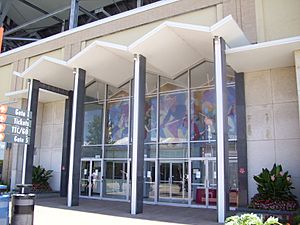
On January 3, 1961, the Manufacturer's Building and the Women's Building were destroyed by fire. They were replaced by the Better Living Centre, which had a cool, modern design on its roof. In 1961, the Hall of Fame building opened north of the Grandstand. It housed Canada's Sports Hall of Fame and the Hockey Hall of Fame. In 1963, the Coliseum got a new, modern front on its south side. The Government of Ontario built Ontario Place on artificial islands south of Exhibition Place. This was to replace its exhibit in the Ontario Government Building.
In 1971, a new plan for Exhibition Place was made. It suggested tearing down many older buildings, building new modern ones, and creating a huge public space with a reflecting pool where Exhibition Stadium was. The plan also suggested a monorail to move people around. Some buildings were torn down, like the Electrical and Engineering Building in 1972 and the General Exhibits Building and Art Gallery. In 1974, the International Building burned down. It was not replaced, and the area became a parking lot. The 1971 plan was stopped when Exhibition Stadium was made bigger for Major League Baseball in 1977. The site officially became Exhibition Place, showing that not much parkland was left.

In 1978, to celebrate 100 years of the fair, a copy of the original 1913 music bandstand was built. North of the park, a new building was added that looked like the exhibition buildings from the 1870s. These buildings mostly host children's activities during the CNE. The park was renamed Centennial Square and is also used for company picnics.

In 1986, the streets of Exhibition Place were used for a high-speed car race for the first time. This race, now called the Honda Indy Toronto, happens every year and is part of the IndyCar Series. The streets are closed to regular traffic to create a race track. This race meant the end of the Bulova/Shell Oil observation tower.
In 1987, the Music Building was badly damaged by fire. Its 1907 outside was fixed, and a new inside was built.
More Year-Round Use
In the 1990s, Toronto needed Exhibition Place to make more money on its own. This led to tearing down the permanent midway buildings and the Flyer roller coaster. The City wanted to charge rent to the midway operator, Conklin Shows. They chose to tear down the buildings instead and set up temporary rides each year for the CNE.
The new Enercare Centre (originally the National Trade Centre) was built in 1997. It was designed to host more and larger trade shows all year. It connected with the Coliseum and Annex buildings to create one big exhibit space. In 2003, the Coliseum was rebuilt and made bigger to be a home for professional ice hockey. It's now home to the Toronto Marlies team from October to April.
To help cover costs, more buildings were rented out for year-round use. The Arts & Crafts Building was rented to the Medieval Times theatre company. The Ontario Government Building became an event space called "Liberty Grand." The Horticulture Building became a night club called "Muzik." The Automotive Building is now used only for private events and conferences.
In 1999, Exhibition Stadium was torn down because the new SkyDome stadium had opened downtown. The site was empty until 2007, when the new BMO Field soccer stadium was built there. This brought Major League Soccer to Toronto. The new soccer stadium also meant the end of the Hall of Fame building. A part of the Hall of Fame's front was kept as an entrance to the new stadium. A WindShare wind turbine was also built west of the Fort Rouillé site as a demonstration project.
In the 2000s, there were many ideas for new uses at Exhibition Place. In 2005, the City of Toronto asked for ideas for an aquarium. The aquarium was later built next to the CN Tower. The City also thought about building a permanent casino at the CNE, but decided not to.
Two new buildings have been added. In the northwest corner, the Toronto Raptors basketball team built a new practice facility. It's also used by the community part-time. In the southeast, along Lake Shore Boulevard, the "Hotel X" hotel was built. The old foundations of New Fort York were found during its construction. The hotel helps support the Enercare and Allstream Centres. The soccer stadium was recently made bigger to host the Canadian Football League's Toronto Argonauts.
2015 Pan Am and Parapan Games
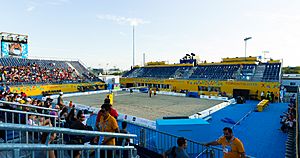
In July 2015, Exhibition Place hosted many sports events for the 2015 Pan American Games. This area was called "CIBC Pan Am Park." The Enercare Centre and Coliseum buildings were used for indoor sports. Temporary facilities for beach volleyball were built south of BMO Field. A water course was set up on Lake Ontario. Because of the games, the 2015 Toronto Honda Indy race was held in June. This gave time for the site to get ready for the Pan Am Games. The site was also cleared in time for the 2015 Canadian National Exhibition, which opened on August 21.
Buildings and Structures
Even though the CNE only lasts a few weeks each summer, many large, permanent buildings have been built over the years. Most of them are used for other things throughout the year.
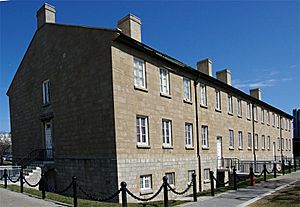
The west end of the grounds is where the first exhibitions were held, and the oldest buildings are here. Five fair buildings were designed by architect G. W. Gouinlock: the Horticulture Building (1907), the Government Building (1912), the Music Building (1907), the Administration Building (1905), and the Fire Hall/Police Station (1912). Just south of Dufferin Gate is Centennial Square, a green space with a bandstand. The Ontario Government Building was added later in 1926. The Bandshell, which looks like the famous Hollywood Bowl, was built in 1936. North of the Bandshell is Bandshell Park, a large open green space. Near the Bandshell is the 1790s Scadding Cabin, the only building from the first exhibition in 1879. There are two large fountains: the Princess Margaret Fountain and the Shrine Monument Fountain.
The central part of Exhibition Place has newer buildings from the 1950s and 1960s. These are bigger than the older buildings to the west. They include the Better Living Centre (for exhibits), the Queen Elizabeth Building complex (theatre, exhibits, and offices), and the Food Building. The BMO Field soccer stadium, built in 2007, is where the 1947 Grandstand and 1961 Halls of Fame building used to be. South of BMO Field is a large open parking lot and midway area. The CNE plans to make this area a public square and move the parking underground.
The east part of Exhibition Place was used most by the military. It still has the only military building left, the Stanley Barracks Officers' Quarters, from the 1840s. This area has a mix of buildings, including the older Coliseum, Horse Palace, and newer buildings. The Enercare Centre, Coliseum, and Industry Building form a large exhibition complex. The Horse Palace (used for horse shows), the Automotive Building (now a conference centre), and the General Services Building are older exhibition buildings from the 1920s. The new "Hotel X" project shows the foundations of New Fort York, which used to be on part of this site.
Sports Venues
Exhibition Place was also home to Exhibition Stadium. This stadium was built from the fourth Grandstand by adding more seats. The original grandstand was built in the late 1800s and was changed or replaced over the years. It was home to the CFL's Toronto Argonauts from 1958 to 1988 and the Toronto Blue Jays (baseball) from 1977 to 1989. Both teams moved to SkyDome (now Rogers Centre) in 1989. The stadium was torn down in 1999 to make space for parking and a bigger midway. However, in 2005, the City of Toronto approved building a 20,000-seat soccer stadium (BMO Field) at Exhibition Place.
Exhibition Stadium (former stadium)
The CNE has had four grandstands since it started. The third grandstand, built in 1907, could hold 16,000 people. It burned down in 1946. The fourth grandstand, known as CNE Grandstand, was built in 1948. This building was one of the first modern-style buildings at the CNE. Its unique roof stood out for over 50 years. It first held 22,000 people but was made bigger over the years to hold up to 54,000. This was to fit the professional sports teams that played there, like the Toronto Argonauts football team and later the Toronto Blue Jays baseball team.
Many famous entertainers performed at the CNE Grandstand. Comedians like Bob Hope and Bill Cosby were featured. Well-known music acts included Duke Ellington, Louis Armstrong, The Beach Boys, The Monkees, The Who, and Tina Turner. After the grandstand was torn down, open-air concerts during the CNE have been held at the Bandshell.
The Blue Jays and Argos left Exhibition Stadium for the SkyDome (now Rogers Centre) in 1989. By then, the stadium was starting to fall apart and was not used much in its last ten years. It was torn down in 1999.
BMO Field (current stadium)
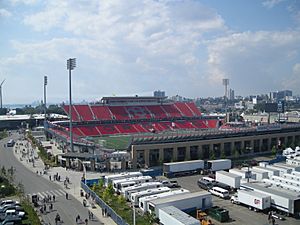
In 2007, the open-air BMO Field soccer-specific stadium was built where the old Exhibition Stadium and Canada Sports Hall of Fame buildings used to be. The Hall of Fame building was torn down for the stadium. The stadium was built for Toronto FC, the Major League Soccer (MLS) team, and the Canadian national soccer team. It can hold about 31,000 people. It opened on April 28, 2007. It was also a main venue for the 2007 FIFA U-20 World Cup. It was made bigger for the 2015 season and got a new roof for the 2016 season.
Coliseum
The Coliseum (built in 1922) is an indoor arena and is now part of the Enercare Centre complex. It's a beautiful building with a classic design. Its main entrance was originally on the north side, but it was changed in 1963 to have a modern entrance on the south. The original front was brought back when the Enercare Centre was built. It's home to the minor league Toronto Marlies professional ice hockey team in the winter. Every November, it hosts the "Royal Horse Show" as part of the Royal Agricultural Winter Fair.
OVO Athletic Centre
The new OVO Athletic Centre was finished in 2016 at the west end of Exhibition Place. This building is a practice facility for the Toronto Raptors National Basketball Association team. It has two basketball courts. Building this facility meant losing some parkland, including a baseball diamond used for a CNE tournament.
Exhibit Buildings
Better Living Centre
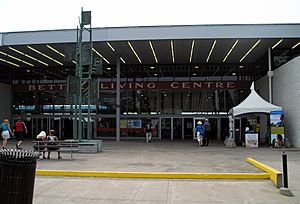
The Better Living Centre is a modern building that opened in 1962. Its first goal was to show new products to the "baby boomer" generation. For many people at the CNE, this building was where they first saw things like colour television, transistor radios, or home computers. It was the place to see the newest models of everything from vacuum cleaners to kitchen appliances.
The building's simple, modern design, with large white shapes and flat roofs, fit its futuristic themes. It was built where the Manufacturers' building used to be, which burned down in 1961. The new building replaced the exhibit space of the Manufacturers' Building and the General Exhibit Building.
Today, the CNE doesn't use the Better Living Centre to show new products. Instead, it's divided in two. One half hosts the CNE Casino in August, and the other half is the "Farm, Food and Fun" pavilion. The building is also used for special events throughout the year, like an indoor amusement park during March Break and a Hallowe'en exhibit in October.
Enercare Centre
The Enercare Centre (built in 1997) has seven exhibit halls with one million square feet (90,000 m²) of space. This new building is connected to the Coca-Cola Coliseum and the Industry Building to create one large, flexible exhibition space. It hosts big events like the Toronto International Boat Show, the National Home Show, and the Royal Agricultural Winter Fair. During the CNE, it has international product displays and animal shows.
Food Building
The Food Building (built in 1954) replaced the original Pure Food Building (torn down in 1953). Water flows down the windows at the east and west entrances. At the main entrance, there are bronze fish sculptures in a pool, and a tall stainless steel tower stands to the right. During the CNE, this building is full of booths from different restaurants and food companies.
Queen Elizabeth Building
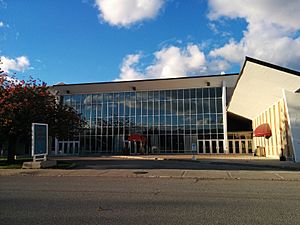
The Queen Elizabeth Building complex (built in 1956) was first called the Women's Building. It was renamed to honour the new Queen of Canada, Elizabeth II. The building has three parts: a two-story office building, the Queen Elizabeth Theatre, and a one-story exhibit hall. The theatre has 1300 seats and is used for shows and concerts. The exhibit hall is a large open space used all year. During the CNE, it shows arts, crafts, and hobbies.
The Scadding Cabin
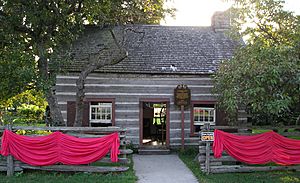
This one-room cabin is next to the Fort Rouillé Monument and the CNE Bandshell. It is the oldest building in Toronto, built in 1794. It was built for John Scadding, who worked for the first governor of Upper Canada, John Graves Simcoe. The cabin was moved from its original spot and rebuilt on the current site for the first Toronto Industrial Exhibition in 1879.
The cabin is a small, two-story log cabin with low ceilings. This design helped keep the heat inside during winter. It's said that John Graves Simcoe, who was over 6 feet (1.8 meters) tall, had to bend down to enter. The building looks much like it did when it was first built. Inside, you'll find furniture that would have been in a house in Upper Canada in the 1830s.
Music and Entertainment Venues
Bandshell
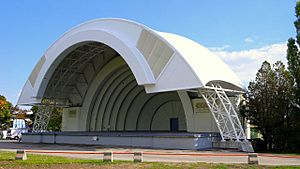
The CNE Bandshell was built in 1936 and looks like the Hollywood Bowl. It's on the west side of the grounds and has hosted many famous performers, including Louis Armstrong, The Guess Who, and Joni Mitchell. More recently, acts like Susan Aglukark and Bob Newhart have played there. The park next to it is called Bandshell Park.
Queen Elizabeth Theatre
The Queen Elizabeth Theatre opened in 1956. It's an auditorium with 1,250 seats and is part of the Queen Elizabeth building complex. It's used for concerts and shows all year.
Gates and Monuments
Dufferin Gates
The Dufferin Gates are the western entrance to the CNE grounds. They are named after Lord Dufferin. The first gate was built in 1895, and a fancier arch was built in 1910.
When Toronto's Gardiner Expressway was built in 1956, the gates were torn down for the road. A new, modern arch was built in their place, designed by architect Philip R. Brook. This arch is 65 feet (20 meters) high and 74 feet (23 meters) wide. It looks similar to the much larger Gateway Arch in St. Louis, Missouri, but it was built earlier. A star decoration was added in 1967 for Canada's 100th birthday. The Gate is a protected historic structure.
Princes' Gates
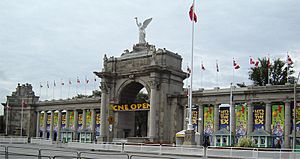
The impressive Princes' Gates were officially opened by Princes Edward and George on August 31, 1927, during the CNE. The gates were built to celebrate 60 years of Canadian Confederation. They were first going to be called The Diamond Jubilee of Confederation Gates. The name was changed because the princes were visiting Canada that year. The first people to walk through the gate were 15,000 veterans in the annual Warriors' Day Parade.
Fort Rouillé Monument
A large stone tower called an obelisk, built in 1887, marks the spot where the French-built Fort Rouillé stood in 1750 and 1751. It was built to help France have a stronger presence in the area and to stop trade from going to an English fur-trading post. It was a small fort with walls and towers at each corner. It had five main buildings. The French soldiers burned the fort in July 1759 as they retreated from English forces.
The area was dug up in 1979 and 1980, and again in 1982, to find parts of the old fort. The outline of the original fort is now marked in concrete around the obelisk. There are plaques on the monument that tell its history.
Shrine Peace Memorial
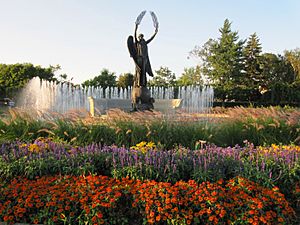
This monument shows a winged angel holding a crown of olive branches. It stands on a globe held up by female sphinxes. It was given to Canada in 1930 by the Shriners. It is a symbol of peace and friendship between the United States and Canada. It also reminds people that Freemasonry promotes peace and good things for everyone. It is located south of the Bandshell, in the middle of a rose garden.
Other Buildings and Structures
- The Automotive Building (1929) is a two-story building. It was first built to show cars during the CNE. Now, it's used for meetings and conferences. The open main floor was turned into a large ballroom.
- The Fire Hall & Police Station (1912) is used by Toronto Police Service, Toronto Fire Services, and Toronto EMS during the CNE.
- The CNE General Services Building was built in 1912 and now holds the CNE Archives.
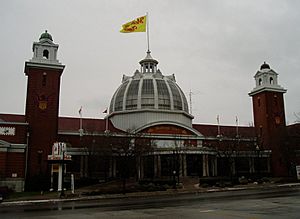
- The Government Building (1911) is also known as the Arts, Crafts and Hobbies Building. It now hosts Medieval Times.
- The Horse Palace (1931) has stables for the Royal Agricultural Winter Fair. This building was considered the best horse facility in Canada when it was built. It's also the permanent home of the Toronto Police Service Mounted Unit (horse police) and a riding academy.
- The Horticulture Building (1907) was built to replace the Crystal Palace. It was used as a temporary morgue after a fire destroyed the SS Noronic in 1949. It now houses the Toronto Event Centre.
- The Music Building (1907) was first called the Railways Building. In 1968, it was used for music competitions and became known as the Music Building. It was almost destroyed by a fire in 1987, but its outside was fixed. It now houses the Toronto Fashion Incubator.
- The Ontario Government Building (1926) now holds the Liberty Grand banquet hall. It used to have exhibits about Ontario.
- The Press Building (1905) was first called the Administrative Building. It was home to the CNE Association until 1957. Then it became the headquarters for media reporting on the fair. More recently, it has returned to its original use as home to the CNE administrators.
- The Officers' Quarters (1840s) is the only military building left on the site. It used to house the Marine Museum.
- Hotel X Toronto is a tall hotel built on what used to be a parking lot. It has two buildings: the main hotel tower and a sports club.
Structures
- CNE Flagpole, put up in 1977. It has a copper ball with a time capsule inside.
- McGillivray Fountain (1968) is a modern art sculpture in Centennial Park.
- Princess Margaret Fountain (1958) was opened by Princess Margaret.
- Sky Ride, a cable car ride introduced at the 2012 CNE.
- Toronto Windmill (Exhibition Place Turbine), a 91-meter wind turbine put up in 2002. It was the first wind turbine in a major North American city. It helps reduce carbon dioxide pollution.
Demolished Buildings and Attractions
- Business Equipment Building (1900).
- Canada's Sports Hall of Fame (1961), later partly torn down for BMO Field.
- The Crystal Palace (1850s), destroyed by fire in 1906.
- The Electrical and Engineering Building (1928), torn down in 1972. The Enercare Centre is there now.
- The General Exhibits Building (1906), torn down in 1962.
- The Machinery Hall, torn down around 1960 for the Gardiner Expressway.
- The Manufacturers' Building (1902), burned down in 1961 and replaced by the Better Living Centre.
- The Process of Manufacturing Building (1905), torn down in the early 1960s.
- Pure Food Building (1921), replaced by the current Food Building in 1954.
- Stanley Barracks - most buildings were torn down in the early 1950s for parking.
- Transportation Building (later International Building), burned down in 1974.
- The Women's Building (1908), burned down in 1961.
- Alpine Way - a cable car ride that was taken down in 1996.
- Original Dufferin Gate - replaced in 1959.
- Gooderham Fountain - replaced by the Princess Margaret Fountain in 1958.
- Mighty Flyer - a wooden roller coaster that lasted until 1992.
- Shell Oil Tower (later Bulova Tower) - built in 1955, torn down in 1985 for the Indy race.
Race Course
Since 1986, Exhibition Place has hosted an IndyCar race, now called the Honda Indy Toronto. The race happens every July. Besides the main race, there are other races and events like concerts. The race track uses the local roads that go through and around Exhibition Place. The roads are closed from Thursday to Monday for the race festival.
The start/finish line is on Princes' Boulevard. From there, drivers go east towards the Princes' Gates, then turn right onto Canada Boulevard. From Canada Boulevard, the track goes right onto Lake Shore Boulevard, which is the longest straight part of the track. Drivers then re-enter Exhibition Place at Ontario Drive, heading north. They turn left onto Prince's Boulevard and continue west. The track then goes to Manitoba Drive, then to Nova Scotia Avenue. At Nova Scotia Avenue, drivers turn right, then go through a series of turns before rejoining Prince's Boulevard and heading back to the start/finish line.
Exhibition Place is one of seven Canadian places that have hosted an Indy/Champ Car race.
Getting Around: Transportation
Public Transit
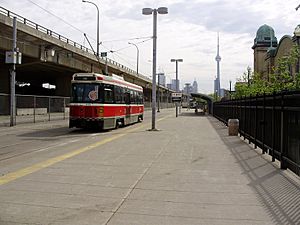
Exhibition Place is easy to reach by public transit. There's a train station called Exhibition GO Station. It's also connected to city transit by streetcar routes 509 Harbourfront and 511 Bathurst Street. These streetcars connect Exhibition Place to Toronto's subway system at Bathurst and Union stations. The Dufferin bus (routes 29 and 929) also goes through Exhibition Place and connects to the subway's Dufferin station.
The first streetcar stop opened in 1916. It was moved a few times and is now back in its original spot.
Roads and Gates
Princes' Boulevard starts at the Princes' Gate and goes west. The other roads at Exhibition Place are named after most of the provinces and territories of Canada.
- Alberta Circle - a short street.
- British Columbia Road - starts at Dufferin Street and ends at Lake Shore Boulevard West.
- Manitoba Drive - a long east-west street along the north end.
- Newfoundland Road - a short north-south road.
- New Brunswick Way - connects Nunavut Road to Remembrance Drive.
- Nova Scotia Avenue - a short road.
- Nunavut Road - a newer street.
- Ontario Drive - a short street.
- Prince Edward Island Crescent - a curved street behind the Better Living Centre.
- Quebec Street - a short street behind the Queen Elizabeth Building.
- Saskatchewan Road - connects British Columbia Road to Princes' Boulevard.
- Yukon Place - a short road behind Liberty Grand.
Northwest Territories is not used as a street name here.
Other entrances to the park, besides Princes' and Dufferin Gates, are just traffic lights:
- British Columbia Gate
- Ontario Gate
- Newfoundland Gate
- Manitoba Gate
Images for kids


